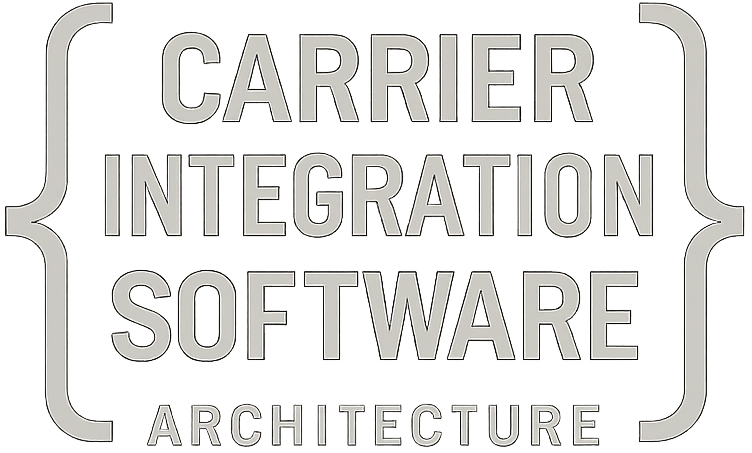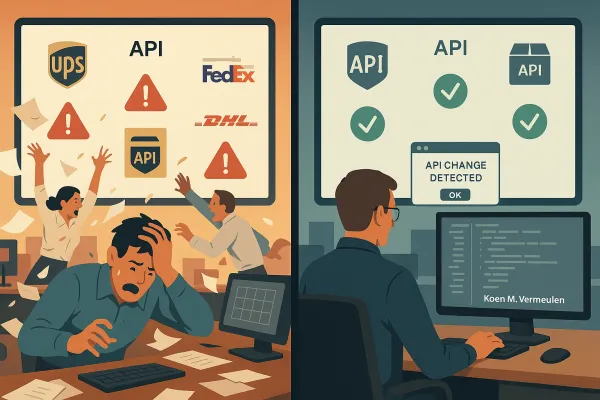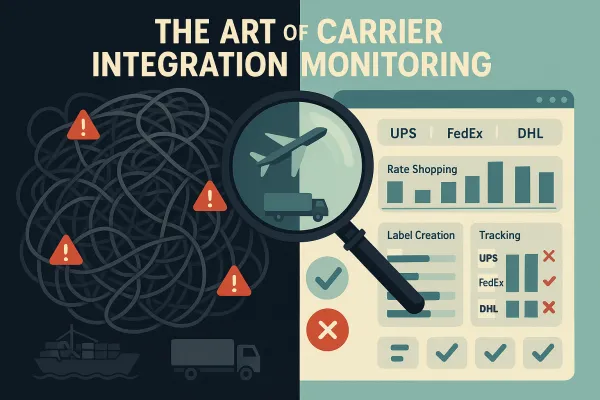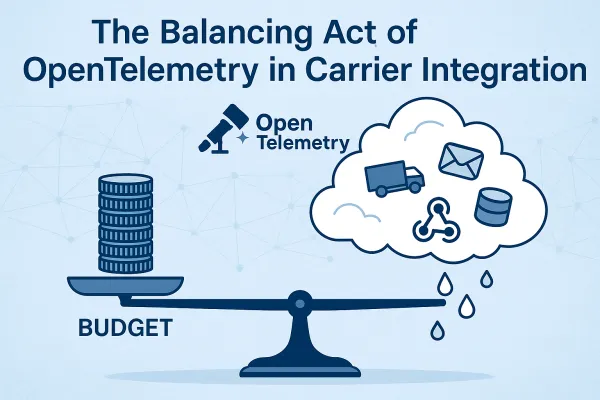Adaptive Rate Limiting for Carrier Integration: Beyond Static Thresholds to Dynamic Traffic Management

Static rate limits are failing everywhere. Financial services, telecoms, and travel sectors faced 40,000 API incidents in the first half of 2025, with attacks projected to hit 80,000+ by year end. The API management market reached $6.89 billion in 2025, yet most middleware still relies on fixed thresholds that can't adapt to real-world chaos.
When DHL changes their rate limits without notice during peak season, or UPS throttles label generation during Black Friday, your static 100-requests-per-minute ceiling becomes useless. One shipper's bulk upload overwhelms your entire multi-tenant platform while others can't even get rate quotes. Sound familiar?
The Failure of Static Rate Limits in Carrier Integration
Fixed rate limits made sense when API traffic was predictable. Now, carrier APIs shift their constraints based on network load, maintenance windows, and seasonal peaks. FedEx uses three throttling mechanisms: quotas, rate limits, and thresholds to manage thousands of daily requests, but these change dynamically while your middleware treats them as constants.
The economics hurt. Over-provision for peak traffic and waste money during quiet periods. Under-provision and watch revenue disappear when legitimate requests get blocked. EasyPost dynamically adjusts rate limits based on system load and other variables, making exact limits unpredictable - yet most integrators still hardcode their client limits.
Multi-tenant fairness becomes impossible with static limits. One customer's 10,000 label batch consumes your UPS allocation while others time out on single shipments. AWS found that fairness requires avoiding failures across all tenants when a single tenant spikes, using per-tenant rate limiting to shape traffic.
Adaptive Rate Limiting Architecture Patterns
Adaptive rate limiting adjusts thresholds in real-time based on three inputs: carrier health, traffic patterns, and tenant behavior. The core algorithm uses a token bucket with dynamic refill rates - unlike static buckets that refill at constant intervals.
Here's the basic architecture:
Dynamic Token Allocation: Each tenant gets a bucket with a base rate plus a variable component. When carrier health scores are high (fast responses, low error rates), refill rates increase. When carriers slow down or return errors, rates decrease automatically.
Circuit Breaker Integration: When a carrier's circuit breaker opens, that carrier's rate limits drop to near-zero while others increase to compensate. This prevents cascade failures when one carrier has issues.
Multi-Tenant Coordination: A central coordinator tracks aggregate demand across all tenants. Fair queuing ensures resources are distributed proportionally during peak demand, with tier-specific limits offering flexibility.
Sliding Window vs Token Bucket Trade-offs: Use sliding windows for burst-sensitive carriers (UPS for labels), token buckets for rate-sensitive ones (USPS for tracking). Token bucket and leaky bucket algorithms handle traffic bursts effectively, allowing surges while maintaining overall control.
Real-Time Traffic Analysis for Rate Adjustment
Effective adaptive limiting requires continuous analysis of three metrics: request latency (P95, P99 percentiles), error rates by carrier and endpoint, and queue depth trends. Your system needs to react within seconds, not minutes.
Time-series analysis beats machine learning for most use cases. Simple exponential smoothing with configurable alpha values (0.1 for stable carriers, 0.3 for volatile ones) outperforms complex models. Track the rate of change in key metrics - acceleration matters more than absolute values.
Traffic Spike Detection: Monitor the second derivative of request rates. A sustained increase in acceleration (not just volume) indicates organic growth vs attack traffic. Legitimate Black Friday ramps differ from bot floods in their acceleration patterns.
Carrier Correlation: When multiple carriers show similar patterns simultaneously, suspect upstream network issues. When one carrier degrades while others remain stable, isolate that carrier's limits.
Carrier Health Scoring for Dynamic Limits
Build composite health scores from weighted factors: API response time (40%), error rate (30%), maintenance windows (20%), and geographic performance variance (10%). FedEx applies thresholds at IP address level and reserves the right to change allocations to maintain equitable access.
Health scores should exponentially decay - a 5-second response doesn't immediately reset a carrier from "degraded" to "healthy." Use half-life decay with 5-minute windows for acute issues, 30-minute windows for sustained problems.
Geographic adjustments matter. DHL's European endpoints might perform differently than US ones. Service-specific scoring helps too - UPS Ground vs UPS Air have different SLAs and should have different health thresholds.
Multi-Tenant Fairness Algorithms
Amazon SQS Fair Queues help maintain low dwell time for other tenants when there's a noisy neighbor, handling this transparently without requiring changes to message processing logic. Carrier integration needs similar protection.
Weighted Fair Queuing (WFQ) works well for different tenant tiers. Enterprise customers get higher weights, but not unlimited access. Progressive throttling gradually reduces limits for non-critical operations during high load, while priority queuing processes critical tasks first.
Per-Tenant vs Shared Pools: Hybrid approaches work best. Each tenant gets a guaranteed minimum allocation (hard limits) plus access to a shared overflow pool (soft limits). When demand is low, everyone can burst. During peaks, guarantees kick in.
Preventing Noisy Neighbors: When a single tenant significantly uses resources, the system flags them as noisy and prioritizes messages for other tenants, ensuring low dwell times for quieter tenants. Apply this to API requests - temporarily reduce limits for tenants who spike beyond their fair share.
Platforms like Cargoson, nShift, and ShipEngine handle these patterns differently. Some use strict per-tenant isolation, others rely on shared pools with dynamic allocation. The right choice depends on your SLA structure and customer mix.
Implementation Strategies and Trade-offs
In-memory coordination works for single-instance deployments but breaks in distributed systems. Distributed rate limiting using probabilistic mechanisms and feedback loops can dynamically scale with network usage growth. Redis-based coordination is common but introduces latency and consistency challenges.
Redis vs Distributed Algorithms: Redis centralizes state but creates a bottleneck. Distributed algorithms like Raft consensus spread load but increase complexity. For carrier integration, Redis usually wins - the coordination overhead is worth the simplicity.
Performance Impact: Adaptive limiting adds 1-3ms latency per request vs static limits. This matters for high-frequency rate shopping but not for label generation. Profile your critical paths and optimize accordingly.
Fallback Strategies: When adaptive systems fail, fall back to conservative static limits, not wide-open access. Better to be slow than down. Implement retry and backoff logic to handle rate limiting as exact limits change day-to-day.
Measuring Success: SLOs and Monitoring
Define SLOs for adaptive rate limiting success: 95% of tenant requests should complete within SLA, no single tenant should consume more than 150% of their fair share, and system-wide success rates should remain above 99.5% even during carrier outages.
Key metrics to monitor: rate limit effectiveness (blocked vs legitimate requests), fairness coefficient (standard deviation of tenant success rates), and adaptation speed (time to adjust limits after carrier health changes).
A/B testing adaptive vs static approaches requires careful tenant segmentation. Don't compare during Black Friday - results will be skewed. Use similar traffic patterns and measure over multiple weeks to account for carrier variability.
Cost-benefit analysis should include both infrastructure costs (Redis, monitoring systems) and opportunity costs (lost revenue from blocked requests, customer churn from poor performance). Most adaptive systems pay for themselves within months through better resource utilization and fewer escalations.
The goal isn't perfect prediction - it's resilient adaptation. Your rate limiting should gracefully handle the unexpected while maintaining fairness across tenants and carriers. Static limits can't do this. Adaptive limits can.





